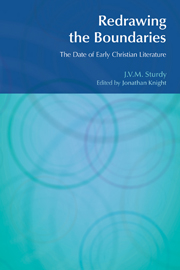Book contents
- Frontmatter
- Contents
- Preface
- Abbreviations
- 1 The Problem Posed
- 2 1 Clement
- 3 The Letters of Ignatius
- 4 Polycarp
- 5 Early Christian Literature: Some Parameters of Date
- 6 The Relationship of the Synoptic Gospels
- 7 Mark
- 8 Luke
- 9 Matthew
- 10 Acts
- 11 The Pauline Corpus: Its Growth and Development
- 12 The Catholic Epistles
- 13 Johannine Literature
- 14 Summary and Conclusions
- Appendix
- Notes
- Bibliography
- Index of Names
- Index of References
1 - The Problem Posed
- Frontmatter
- Contents
- Preface
- Abbreviations
- 1 The Problem Posed
- 2 1 Clement
- 3 The Letters of Ignatius
- 4 Polycarp
- 5 Early Christian Literature: Some Parameters of Date
- 6 The Relationship of the Synoptic Gospels
- 7 Mark
- 8 Luke
- 9 Matthew
- 10 Acts
- 11 The Pauline Corpus: Its Growth and Development
- 12 The Catholic Epistles
- 13 Johannine Literature
- 14 Summary and Conclusions
- Appendix
- Notes
- Bibliography
- Index of Names
- Index of References
Summary
This book has been written in the conviction that the current tendency of scholars to give the bulk of the New Testament material an early date is wrong. Although it is true to say that New Testament scholarship has moved in recent years towards a greater acceptance of pseudonymity and of relatively late datings, I have been prompted to write by the conviction that this broadening of horizons does not go far enough. Twenty years ago it would have been acceptable to suggest that, as well as the Pastorals, Ephesians is post-Pauline; but it would have needed apology and argument (at least in the English-speaking tradition) to add to these “disputed writings” Colossians and 2 Thessalonians. It is now more widely acceptable to place 1 Peter in 115 CE; and it is beginning to be acceptable to suggest that there are passages in the Pauline epistles which are later additions (e.g. 1 Cor. 14:24–35; 2 Cor. 6:14–7.1; Rom. 13:1–7). It is interesting to note in the second edition of the Jerome Bible Commentary a remarkable shift from the first edition on just these points (although Jerome is still conservative in insisting on an apostolic authorship for 1 Peter!). We must be clear that scholarship moves in cycles and follows trends. This creates the need for critical voices to be raised against the dominant trends, so that the strengths and weaknesses of a particular position (and thus of a particular generation) can be given appropriate consideration.
- Type
- Chapter
- Information
- Redrawing the BoundariesThe Date of Early Christian Literature, pp. 1 - 3Publisher: Acumen PublishingPrint publication year: 2008

